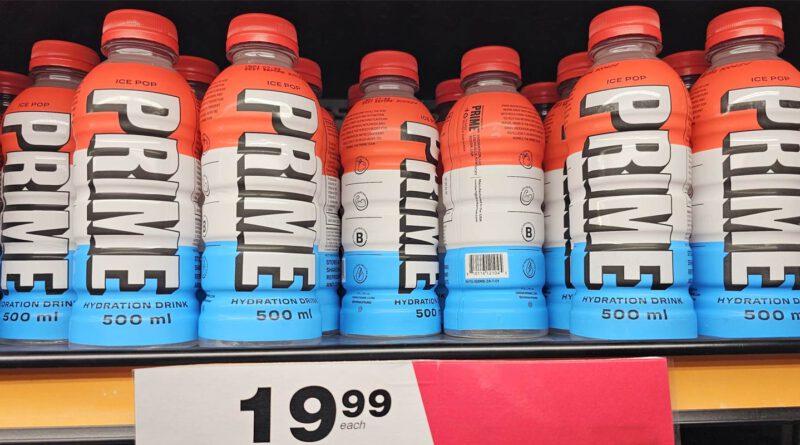Prime’s collapse a cautionary tale of social media hype
It was primed for success. And then suddenly it wasn’t.
The fizz has gone out of the energy drink Prime, developed by US YouTuber Logan Paul and his British counterpart KSI (real name Olajide Olatunji) – social media “influencers” who have more than 40 million followers between them on the Google-owned video platform.
Needless to say, when they launched Prime Hydration – in January 2022 – it was an immediate success with Gen-Z followers desperate to be seen with a neon-coloured bottle in their hands.
South African fans were keenly aware of the social media frenzy surrounding its launch in the US and UK, and took no time to jump on the bandwagon. There was a frenzy to be seen with the sugary drink.
The power of Paul’s and Olatunji’s influence created a kind of mania among their target audience last year, driving up sales around the world – and in South Africa.
Shoprite Group’s Checkers was quick to latch onto the opportunity, sourcing it directly from the manufacturers and utilising its sophisticated distribution system to offer Prime drinks for R40 a pop. When the drinks were first offered on Checkers’ popular on-demand shopping app Sixty60, the initial stock reportedly sold out in less than 30 minutes.
But that was last year. Today Checkers has shelves and shelves full of the drinks, now being sold for half price – R20 each. When TechCentral visited Checkers in Cresta in Johannesburg at the weekend, thousands of bottles of Prime were dotted all around the supermarket, with little sign of any interest in them, despite the cut-price sale. In short, Checkers appears to have far too much stock on hand to meet collapsing demand.
‘Just another drink’
A spokeswoman for Shoprite declined to comment, saying the retail group is in a closed period and is not in a position to comment on sales-related questions.
Flux Trends partner and futurist Bronwyn Williams told TechCentral that while the global brand has managed to convert its viral moment into sales momentum, it’s safe to say its hype cycle has died down – and that the brightly coloured bottles are no longer the status symbol they were for a brief time.
“Both the scarcity and novelty value that justified once-extraordinary prices have diminished, and now it’s just another drink and has the market value of the same,” Williams said.
Read: YouTube takes aim at TikTok
“We can expect a similar trajectory for Stanley cups, the now-coveted collectible personal metal thermos mugs that trended online and IRL (in real life) over the past festive season.”
Last year, because the drink was not available everywhere, it was considered a scarce commodity — which created the perception of value, Williams said. Its arrival in Checkers stores changed that.
[embedded content]
“Then there’s the issue of status. Even R40 is steep for what is essentially sugar water,” she said. “The price lends an air of exclusivity, making the product all the more desirable. Displaying a bottle of Prime shows that you are fashionable, you have taste and you have status in society.”
Brand and marketing expert Jeremy Maggs agreed that Prime was initially priced as a premium product, and benefited from the perception of exclusivity and quality.
“The dramatic price reduction suggests to consumers that the product was overpriced to begin with. This shift, I believe, has diluted the brand’s perceived value, and when that happens, erosion of customer loyalty and brand equity follows like night after day.”
Maggs said there were mismanagement issues. “Firstly, an overreliance on social media trends for brand promotion, while effective in generating initial hype, can lead to unsustainable long-term growth if not complemented by broader marketing strategies.
“This approach risks aligning the brand too closely with fleeting trends, making it vulnerable to rapid decline in popularity as consumer interests shift. Setting the price too high without establishing a strong value proposition deterred potential customers and led to an inventory surplus, prompting drastic price cuts.”
All this underscores several key lessons in brand management, Maggs said.
“It highlights the importance of building a brand on solid foundations beyond the initial hype, emphasising product quality, customer satisfaction and a value proposition that justifies its pricing.”
Prime’s cautionary tale
He said the case illustrates the risks of relying too heavily on social media trends for brand promotion.
“While social media can be a powerful tool for generating awareness and engagement, it should always be part of a diversified marketing strategy that includes traditional and digital channels to ensure stability and sustained growth.
“All of this serves as a cautionary tale about the pitfalls of trend-driven marketing and the importance of strategic brand management. It underscores the need for brands to navigate the delicate balance between capitalising on trends and building a lasting, value-driven relationship with their consumers.”

Jeremy Sampson, MD of Brand Finance Africa and an expert on brand management and marketing, said: “Checkers obviously took a calculated risk that paid off in the beginning. I remember all the razzmatazz in Cape Town last year when it was launched. But a few weeks ago I was fascinated to see in my local store that it had moved from its prime spot and was tucked away at the back. Obviously it was a fad that has come and gone.
“There are lessons to be learnt from this. Coca-Cola is also a fizzy drink, but it’s been going for 132 years because its brand marketing is right.” — © 2024 NewsCentral Media
Get breaking news alerts from TechCentral on WhatsApp
Source: techcentral.co.za


